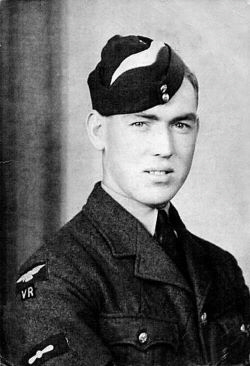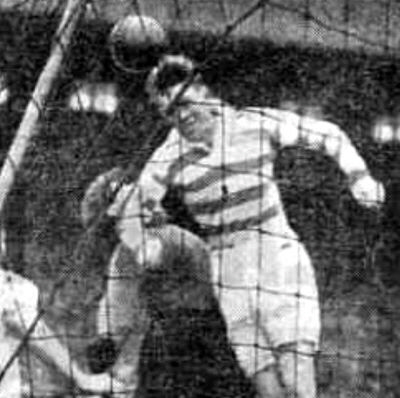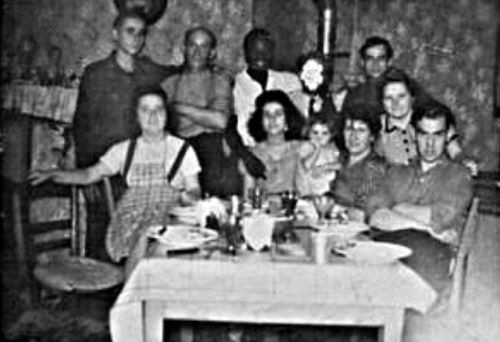|
John Conway RAFVR - 576 Squadron – 1944
D Day Evader

John Conway
Pre war
John Conway was the eldest of 10 children from a Catholic mining family from Fife, Scotland. His father, also John, was an intelligent man who, like so many of his generation, lacked opportunity and went to work down the pit aged 14. He resolved that, if at all possible, his sons would have a better life. John was academically very successful at school, and he gained a bursary to Edinburgh University completing 3 years of a 4 year degree course studying English and Modern Languages before the war interrupted his studies.
He was also a talented footballer and was scouted by Glasgow Celtic and signed for them in 1938, aged just 17. He was at first loaned to Alloa Athletic F.C. but joined the Celtic squad in 1940. He played inside right, and after his debut season in 1940-41 it was said of him
“Celtic have struck oil… Conway is undoubtedly one of the most thrustful inside men thrown up since the start of the War”.

John Conway playing for Glasgow Celtic early war
WW2
His training as an air bomber took him to Canada, and on his return to the UK he agreed to join an all-Scots crew being assembled by a New Zealand pilot of Scottish descent. However, shortly after, John contracted scabies, spent a few days in the medical unit and his CO held him back to complete the training he had missed as a result. This meant that his crew had to replace him. Later in the war this crew would be shot down with no survivors.
He then joined Squadron 576 at RAF Elsham Wolds, Lincolnshire, and became one of the crew of Lancaster ME811 captained by Canadian pilot Gordon Bain. On D-Day, the Bain crew was part of the operation to bomb the railway infrastructure of Vire in Normandy to hinder the German advance by destroying transport links. The Lancaster somehow got ahead of schedule and arrived slightly early. On nearing Vire it was shot down a German night fighter which successfully targeted the port wing where the fuel tanks were housed. They managed to release their bombs on target before abandoning the aircraft. Six of the seven crew parachuted out but tragically the rear gunner went down with the plane.
John landed in a field of cows and badly sprained his ankle, exacerbated by the loss of his flying boot during his descent. The cows’ loud mooing alerted the Germans so he hastily buried his parachute and harness and set off, hobbling, as fast as possible. He could hear German voices at a nearby farm.
He transferred his socks from his good foot to his injured one, and managed to walk till dawn. He hid under a tree beside a stream and hunkered down to wait a day or two as instructed during his training. While hidden there he watched a Spitfire attack and destroy a German lorry. He ministered to his very swollen ankle as best as he could and at dusk the next day set off southwards, thinking maybe to escape to Spain. Reasoning that it was too dangerous to travel on the roads, he stuck to the fields. His escape kit comprising a silk map, compass and vitaminised caramels was invaluable. The going was arduous as he was in ‘bocage’ country, where high dense hedges bordered the fields and were very difficult to get through. After hours of walking, he at last came to a village church, and hid amongst the gravestones till dawn. He could see a vegetable garden over the wall, so he moved there and concealed himself behind the runner beans. Eventually an elderly lady appeared. She got the fright of her life when he stood up but rallied and went off to find the mayor.
The mayor, a local farmer, insisted on hiding him in the hayloft in his barn and dismissed John’s concern about the dangers to the family if he were discovered. John was to stay there for about 4 weeks. Fortunately he had learned French at school and could speak it well enough to get by. As his ankle healed and his fluency improved he integrated into the family and helped out on the farm. His feeble attempts at milking provoked much laughter, but he did better at hay-making. He was treated royally, dining well on farm produce and imbibing the local Calvados. The family’s priest, who lived in the nearby town of Tinchebray and spoke some English, called several times and they had interesting philosophical discussions. The weather turned bad, there were only occasional Allied planes and few Germans around. John felt a growing impatience at the apparent slow progress of the Allied assault.
Gradually, however, Allied planes came over in greater numbers and more Germans came to the farm for food. Refugees started to appear as the fighting got closer. Two ragged, pitiful creatures approached the farm one day, and were fed and housed overnight. It transpired that they were Russian prisoners who had escaped from German work parties disrupted by the Allied advance. Indeed, many French farmers, whose sons were called up, discretely employed such escapees to replace the lost manpower.
One day, a formation of five American Thunderbolts flew over. Minutes later a coordinated attack of flak and FW 190s shot one Thunderbolt down. The pilot was killed, and the mayor was required by the Germans to bury him, not in the churchyard but where he fell. The mayor had retrieved the airman’s identity discs, which showed he was of Polish origin. The mayor’s sons and John prepared a cross with his name, cleaned out a box from the farm to make a coffin and dug a grave beside the hedgerow. He was haunted ever after by the sight of the airman’s broken body. Several villagers gathered at the graveside to lay flowers and stood praying with bowed heads. Finally two young women laid a wreath.
John had become gradually aware, from the comments of visitors to the house, locals who approached him and even from the knowing looks of those at the graveside, that he was no longer a secret. He trusted the family’s integrity but reasoned that an unintentional slip of the tongue in the wrong quarter could betray him. So he asked the mayor, as tactfully and gratefully as he could, to arrange to move him on. This did not go down well. However, the priest intervened on his behalf and so it was decided.
He was moved on foot some considerable distance away to hide out with a head teacher called Guy, his wife, Fernande, and little daughter. It is likely that Guy had dealings with the French Resistance. Here John had more contact with passing Germans, who sometimes used the adjoining schoolroom as a billet and availed themselves of the family’s cooking facilities. They would hide their vehicles (including, on one occasion, a Tiger tank) under the trees in the nearby lane. John’s cover story, if necessary, was that he was from Alsace, to explain his Scottish/French accent. On one occasion he was asked directly by a German why he wasn’t in the army, but his answer seemed to satisfy the soldier, who didn’t pursue it, much to John’s relief.

John Conway Fernande and Maryvonne
One of his biggest surprises was the presence of a black soldier in the house. He was a Senegalese prince, the leader of some captured ‘tirailleurs’, whom the Germans had been transporting to work on the northern defences. Their driver had left them unattended in a lorry while he stopped for coffee. Guy happened to be nearby and effected a bold rescue, guiding the soldiers into the surrounding countryside, where they were hidden temporarily by local people. The twenty-strong troup was now holed up near an abandoned farmhouse in a wood some kilometres away. On one occasion John went with the family to take them food and was impressed by their disciplined organisation, with sentries, tunnels to hide in and food plants growing inconspicuously amongst the trees. Senegal was a French colony and many of their young men fought in both wars for the French.

John Conway front row right with Guy and family and Senegalese soldier in Guy’s living room
Guy was the local representative for refugees and held limited funds for those most in need. One Sunday the church collection was in their aid, and Guy invited John along. They arrived to find a vehement argument between a German officer and the priest. The German and his men wished to attend church, but insisted that they kept their weapons on their persons, as per their military regulations. The priest was appalled, this was the House of God. But the Germans prevailed. When Guy came to pass the plate, he made a point of including the Germans, who were thus obliged to give money to help the very people they had made homeless.
On one occasion John was persuaded to embark on a foolhardy undertaking. Two young friends of Guy’s turned up with a sack containing hand grenades, a dismantled Sten gun and some bullets. They planned to ambush a German lorry that drove along a nearby road at 10pm each night. John was horrified when they challenged him to go with them, but feeling that British honour was at stake, agreed. So the three of them broke curfew and hid by the roadside. Much to his relief, the lorry did not turn up that night!
After a few weeks the Allied troops reached them, and John gave himself up to an American contingent. He spent the rest of the war as a meteorologist at RAF Leuchars in Fife, near his home village.
Post War
A few years later John Conway with his wife and daughter visited Guy and family and they returned the visit the following year. In civilian life John was a primary teacher and later a head teacher.
He died in 2002, aged 82.

John Conway 2000
….......
The Bain crew
Of the others in the Bain crew F/O Gordon Bain, skipper, Sgt Bill Williams, flight engineer, Sgt Walter Charnock, gunner, and Sgt Thomas Mitchell, wireless operator all successfully evaded capture, like Conway being hidden by courageous local people. F/Sgt John Walkty, navigator, landed right in the middle of a German position, was taken prisoner and sent to Stalag Luft 7, in Silesia. Along with thousands of other POWs in the eastern camps, he was evacuated by the Germans ahead of the Russian advance, and forced to walk west to Stalag 111-A in the worst winter that century, with storms and sub-zero temperatures. He did make it through this ordeal, returned home to Canada and lived on into his 80s. Sgt Gordon Humpheys did not survive the crash and is buried in Chenedolle churchyard, near where the Lancaster came down.
Thanks to Viv Calver for this precis of her father’s book which should be published in due course. Also the photos.
………………..
|